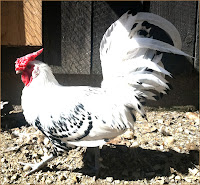The first time it happened, I did not think too much about
it. A knock on the door in the wee hours of the morning by the police…but by
the third time I was combing the vast fields surrounding my house looking for
two very naughty ponies in the freezing cold and total darkness, I was ready to
admit I have a problem.
While I am snuggled up warmly in my bed, my ponies have decided
before the snow comes, they will use the middle of night to travel the
countryside in quest of any last remaining grass patches on which they can
nibble. They do not escape during the day. Ah no for even they know that is far
too obvious, and they are unlikely to graze unseen. They wait until the coldest, darkest parts of
the night, when the roads are empty and even the dairy farmers are asleep.
The first morning, when I was awakened by an officer asking
if I was missing any miniature horses, their escape path was clear. I looked
out the window and saw the fence was broken. After retrieving them from the
neighbor’s yard, who of course had generously provided them with apples, bread
and other goodies to keep them from moving on, I fixed their pen and went to
work feeling like that was an unfortunate one-time event. I was just happy the
ponies were safe and sound, and I was not arrested for animal neglect, neighbor’s
Christmas decoration vandalism or any other such travesty that could befall the
owner of rogue ponies.
The next night it was closer to 2am when the knock on the
door awoke me from sleep. This time an older gentleman was inquiring if I was
missing any ponies, as he just saw two galloping down the cornfield alongside my
house. I woke up Bridget, threw on some clothes and headed out after them.
However, now ten minutes after their last sighting, they had disappeared.
Thinking of the fabulous junk food breakfast they had been
served the day before, we headed to the neighbor’s house hoping to find them.
Alas, no ponies. An hour later, frozen, tired and crabby, we spotted them
grazing in a tall patch of grass not far off the road. Walking them home,
sputtering under my breath, we arrive back at their pen to find it perfectly
intact, gate closed. How did they get out?
Turns out in talking with other pony owners, ponies, if so
inclined, will carefully step through the tape on a paddock, without disturbing
the tape. The first time, they were sloppy and left obvious evidence, but now
it appeared they mastered the art of a graceful escape.
I would like to say I have solved this problem, but just
last night, the dogs started barking and all suspicions were confirmed, as a
large dark objects were spotted galloping down the field. Sure enough… no
ponies…no broken fence...and another late night of tracking my naughty boys
through the dark pastures that surround my house. Covered with burs, and happily
munching the last bits of greenery that still survive in the fields, my ponies
looked at me, bundled in my coat, flashing my light in their eyes, as much as
to say “Come on, we know this will all be gone soon…we just can’t resist the
last taste of autumn.” I never thought I
would say this, and those who know me will be in shock, but I truly, from the bottom
of my heart, hope the snow comes soon!









